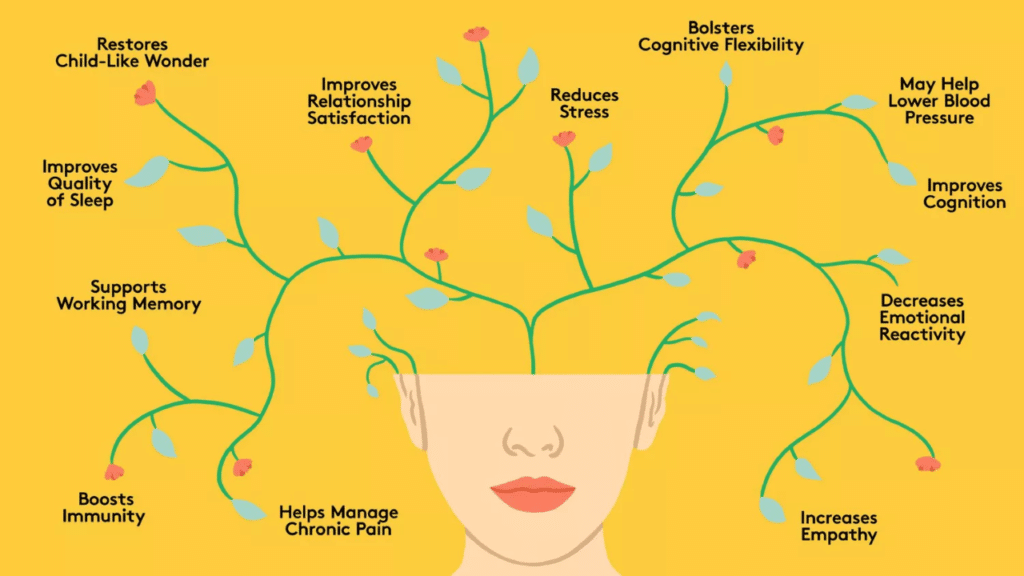Written by: Beverly Sharifian, LPCC
Many of us have heard of the immense benefits of meditation. There are great strides in neuroplasticity research indicating that our brains are malleable and have the ability to restructure themselves (Kabat-Zinn, 2013; Shapiro, 2022). What we often forget is that mindfulness, which is the ability to be aware from moment to moment, while suspending any judgment (Kabatt-Zinn, 2013) can be practiced throughout the day. I regularly try to increase my own present-moment awareness, so I thought I would share some practical ways for incorporating this practice into your daily life.
Give Your Mind a Much-Needed Break
If we pay attention, it is likely that we will be able to tune into the endless stream of thoughts that are running in the background of our minds. At times, these thoughts even come to the foreground, as some may have experienced at nighttime, resulting in difficulty falling asleep. Our thoughts can be racing at such a fast pace, making it difficult for us to catch up. Rather than judging ourselves for this or panicking, we would be best served by giving the mind some quiet time. We have so many forms of entertainment and rewards at our disposal that it is rare to sit in quietude. Allow yourself to sit without your phone or without the television on in the background. Take a drive without listening to music or a podcast. Avoid talking on the phone while doing chores or errands. Enjoy a meal by yourself. The big picture is to give yourself permission to simply be alone in silence. Should your mind begin to wander, the next practice will suggest where you can shift your attention to.
Incorporate Your Senses
Building on the idea of reducing our need for constant stimulation, we can attempt to tune in more fully to the environment around us. We may at times forget that the simple pleasures can be just as rewarding. When you are out in nature or going for a walk, for instance, try to pay attention to the sights around you. Listen for any sounds you might hear, including the sounds of the wildlife nearby. Reach out and touch something, like the bark of a tree. Breathe in the scent of the fresh air or the fragrance of a flower. For those who enjoy a good meal as much as I do, use your senses to eat more mindfully and determine whether that changes any part of the experience. Often people will find that their level of satisfaction and satiation increases. You may even find that flavors are more pronounced.
Cultivate Beginner’s Mind
In his book, Full Catastrophe Living (2013), Jon Kabat-Zinn outlines some of the attitudes of mindfulness to promote a more concrete understanding of this quality. He describes beginner’s mind as the joy and excitement resulting from experiencing something as though it is your first time (Kabat-Zinn). This can inherently foster gratitude, as we can begin to take day-to-day experiences for granted. We can remind ourselves to approach things with curiosity and to acknowledge how remarkable they can be. Think about some of the natural sights around you- lakes, mountains, oceans- and how you can learn to marvel at those things again. With beginner’s mind we can spark excitement about even minor things, like treating ourselves to an ice cream cone or a piece of cake. It can bring a sense of novelty and appreciation to even familiar experiences, including time spent with loved ones.
Practice Self-Compassion and Acceptance
According to Dr. Shauna Shapiro (2022), a leading researcher in the arena of mindfulness and self-compassion, we should approach meditation with a stance of “kindness, compassion, and curiosity.” The stream of thoughts in the background of our minds can often be filled with self-criticism and self-judgment. Perhaps we are even judging ourselves for not being mindful enough or forgetting to put some of these principles into practice. We want to avoid feeding that critical part of ourselves as much as possible (Downs, 2021). Being mindful involves nurturing ourselves in a way that we often forget to. Leading any mindfulness practice with genuine curiosity will result in substantial benefits, despite not being able to see the immediate results. By accepting ourselves as we are, as well as the situations as they are, we can deter the seeds of self-doubt from growing. To learn more about self-compassion, acceptance, and non-judgment, I would recommend reading Good Morning, I Love You (Shapiro, 2022) and Full Catastrophe Living (Kabat- Zinn, 2013).
A number of clients have told me that meditation doesn’t work for them or amplifies their feelings of anxiety. My usual answer is that they may need practice taking their expectations out of the equation. Even one minute of mindful practice can be significant. With the multitudinous benefits, I believe that everyone can find a mindfulness practice that works for them. My goal in sharing these tips is that you can reduce your need for perfection or to “get it right” and instead, seek out pockets of mindfulness throughout your day or your week. You can start by cultivating smaller practices before working your way to a meditation practice, knowing that there are plenty of ways one can practice being mindful. Just keep in mind that you are planting seeds that will take time to sprout.
References
Downs, R. (2021, October 21). An interview with Dr. Shauna Shapiro of Good Morning, I Love You and the simple mindset shift that can change your life. Real Food, Whole Life. Retrieved February 8, 2023, from https://realfoodwholelife.com/feelgoodeffect/good-morning-shauna-shapiro/
Kabat-Zinn, J. (2013). 1-3. In Full catastrophe living: Using the wisdom of your body and mind to face stress, pain, and illness. essay, Bantam Books.
Mayo Foundation for Medical Education and Research. (2022, April 29). A beginner’s guide to meditation. Mayo Clinic. Retrieved February 8, 2023, from https://www.mayoclinic.org/tests-procedures/meditation/in-depth/meditation/art-20045858
Shapiro, S. (2022). Good morning, I love you: Mindfulness and self -compassion practices to rewire your brain for… calm, clarity, and joy. SOUNDS TRUE.
Graphic by: YEJI KIM

